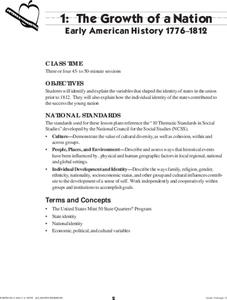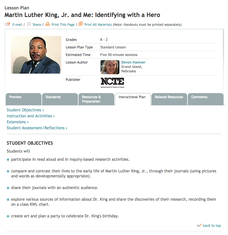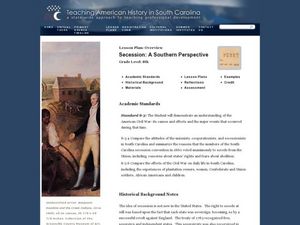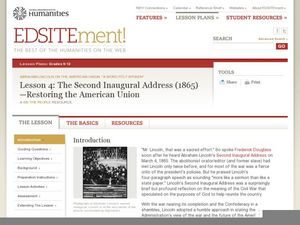US Mint
The Growth of a Nation
Young historians explore the identity of the early United States in this four-part instructional activity series. Working in groups of three, students research the political, economic, and cultural atmosphere of each member of the...
Curated OER
American Music Styles: European Roots and African Influences - Lesson 3
Students describe some of the characteristics of country and blues music. They see how country music rose to a nationally known music style. They write a two-paragraph essay on what they think country music be like in the next 100 years.
Curated OER
Indians in Georgia: How Do We Know What We Know?
Students discover archaeology by investigating the history of Native Americans in Georgia. In this U.S. history lesson, students participate in a mock archaeological excavation in their classroom by recovering artifacts and drawings...
Curated OER
Native Indian Culture: Plains Indians in Montana
Students examine the culture of the Plains Indians. In this Montana history instructional activity, students view a PowerPoint presentation regarding the social, religious, and traditional life of the Plains Indians.
Curated OER
America the Bountiful
Fifth graders explore the impact exploration and colonization of North America had on human history. In this American colonies lesson, 5th graders compare differences between colonial areas. Students investigate the global impact of...
Benjamin Franklin Tercentenary
Benjamin and the Way to A Good Life
Young scholars explore American history by reading biographical text in class. In this Benjamin Franklin lesson, students research the famous inventor by reading assigned text and answering reading comprehension questions afterwards....
Curated OER
Cattle Trails
In this cattle trails study guide worksheet, learners read about the American West. Students read 4 sections of information.
Curated OER
Childhood in Early 19th-Century America
Learners interpret and analyze primary source documents and compare and contrast childhood today with that of the past.
Rutgers University
African-Americans in WWII
Using transcripts of interviews of African-Americans who served in WWII, class members work in pairs to understand their experience. Prior to the group work, the teacher provides background on WWII and the African-American experience....
HISTORY Channel
Westward Expansion of the United States
How did early American pioneers decide what to take with them on their journeys, and what was their traveling experience like? Here you'll find a collection of activities to help you explore Westward Expansion with your young learners.
Curated OER
The Early American Contradiction
Students use the Constitution and Declaration of Independence to investigate the apparent contradictions between slavery and freedom. The activity looks at the reasons for the incorporation of slavery into early colonial life even with...
Curated OER
Noncombatancy and the Seventh day Adventist Church
Upper graders investigate how the Seventh Day Adventists are objectors to the practice of war. The lesson covers the Civil War and examines the church's position about the practice of war. The research extends to modern wars and learners...
Alabama Department of Archives and History
Changes in Transportation over Time
Planes, trains, and automobiles. How many ways to travel are there? Scholars learn about modes of transportation in the past and how they have changed over time. Budding historians view a timeline, participate in group discussion, and...
Alabama Department of Archives and History
Two Different African-American Visions: W.E.B. Du Bois and Booker T. Washington
The strategies civil rights activists Booker T. Washington and W.E.B. Du Bois proposed for blacks to achieve racial progress is the focus of an activity in which class groups identify the strategies as well as the benefits and drawbacks...
Curated OER
The Monroe Doctrine: Whose Doctrine Was It?
Was James Monroe the sole contributor of the Monroe Doctrine? Young scholars study the doctrine and cite evidence to show contributions of John Quincy Adams and Thomas Jefferson in its formulation.
ReadWriteThink
Martin Luther King, Jr. and Me: Identifying with a Hero
Here, young historians compare their early lives to that of Dr. Martin Luther King Jr.'s. They listen to a read aloud of a story by Dr. King's sister, and then write in the provided reflective journal template. Lastly, they share their...
Curated OER
Understanding Loyalist Vs. Revolutionary Ideology
Students understand some causes of the American Revolution. Students learn the viewpoints of the loyalists and the American Revolutionaries. Students learn a timeline of facts which they use to compare and contrast the views of the...
Curated OER
History of the American West
Ninth graders research early mining in California. They study the "placer method" for mining gold, which is surface mining that does not involve tunneling. They examine what it was like for the early miners to pan for gold with...
Curated OER
Entertainment and Recreation in the Early Twentieth Century and Today
Eleventh graders research entertainment and recreation in the early twentieth century using primary sources and the book From the Hidewood, by Robert Amerson. They compare the rural experience of the time period to the national...
Curated OER
What Made George Washington a Good Military Leader? What Are the Qualities of a Good Military Leader?
Students examine the military leadership of George Washington. For this military leadership lesson, students use Internet and print resources to research Washington's military experience and his successful military campaigns. Students...
National Endowment for the Humanities
Slavery and the American Founding: The "Inconsistency Not to Be Excused"
High schoolers examine slavery in the revolutionary and colonial eras of the United States. In this slavery lesson, students investigate the presence of slavery in early America, the language of the Constitution, and the intent of the...
Curated OER
Secession: A Southern Perspective
Eighth graders determine how secession impacted South Carolina as well as the United States. In this American Civil War instructional activity, 8th graders examine selected primary and secondary sources in order to study the state's...
Curated OER
The Crittenden Conway Duel
Students explore primary and secondary sources. In this primary and secondary source lesson, students investigate a crime scene. Students search for evidence around the classroom and evaluate their findings. Students write a crime report...
Curated OER
The Second Inaugural Address (1865)—Restoring the American Union
Students explore the content of Abraham Lincoln's Second Inaugural Address. In this Abraham Lincoln lesson, students analyze the text of the speech to determine how Lincoln sought to reconstruct the country as the Civil War drew to a close.

























